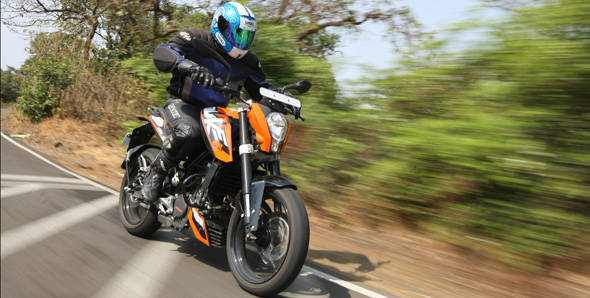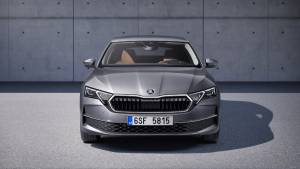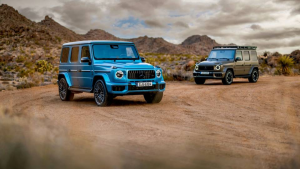KTM 200 Duke roadtest

Flamboyance isn't easy to carry off. But when you get it right, there's nothing else in the world quite like it, is there? The KTM 200 Duke, I think, carries it off. Bajaj bought into the Austrian company quite a while back, and the company's famously orange motorcycles have only now entered the market. As usual, Bajaj is dancing to their own tune. They eschewed the fast rollout via CBU method -- well accepted in our market -- for a slower but possibly a more rewarding approach. They took the time to develop their KTM platform for local manufacture and sales as well as exports in the KTM 125 Duke.
An instant hit abroad, the small Duke was simply too expensive to have any reasonably shot at success in India - despite making more power than almost all of our 150s and weighing significantly less than them all. And so the KTM launch came only after the 200 Duke was ready for prime-time. Well, ladies and gentlemen, it is now show time.
Styling, build and finish
The show begins, obviously with the Duke's incredible presence. It's like trying to have dinner without looking at the F-14 Strike Eagle parked on top of the dining table. Part of the appeal is unfamiliarity. Gerald Kiska, who designs KTM's unique motorcycles seems to have a pathological phobia of curves and the wheels and tyres are about all that is round on the motorcycle. Or at least that's what a quick glance seems to suggest at first.
Continue ogling -- it isn't really optional -- and you will see the details. There is a sense of lightness in the motorcycle because there's a lot of air between the rear wheel and the tail piece and even the space above the engine head doesn't seem to detract from the sense of lightness. There is also a sense of muscled fitness about it. There's no rounded surfaces to suggest any flab at all. It's all planes set at angles to each other, creating a menacing, aggressive shape that seems densely accumulated around the engine area with only a tiny tail end and wheels stuck out of the mass.
I believe the KTM is among the best looking motorcycles in India today. And it manages this without having many of the classical elements that are usually considered necessary for being considered beautiful. The shape of the headlamp, for instance, is not something I want to dwell on - I mean what is that thing supposed to be anthropomorphised as? Or should that be equinothromorphised?
Point is, it's a structured but out-of-the-box styling ethos that results in a superb looking motorcycle. And a word of caution, it's a lot smaller than it looks in the pictures so it looks dramatically more character-ed in the flesh.
Build quality is excellent and having thudded mercilessly through bump after bump -- and we will return to that topic in a bit -- I can confirm that aside from the occasional slap of the chain high-fiving the bottom of the swing arm over the gnarliest of stuff, everything suggests epic strength and rigidity. It's almost as if the KTM wasn't built from parts and components and held together by nuts and bolts, but was CNC machined out of a giant block of plastic and metal. Since I've mentioned the bolts, I must also note that some of the nuts and bolts of this machine are a bit of a shocker. For instance, that deliciously crafted swingarm, braced externally and painted a snazzy anthracite (grey) colour ends on a solidly ordinary looking swingarm axle.
The bolts wouldn't be an issue on their own but the contrast between the detailed design of some of the components and these ordinary ones is startling. Want some examples? Neat handlebar, neat mounting, sits close to a brown coloured engine kill switch, Pulsar switchgear and a solidly ordinary steering head bolt. The last of which, again, sits on what looks like a well-designed, carefully crafted top triple clamp. And again. Then you notice the neat all-digital meters and then your eyes veer to the perfectly ordinary, Pulsar-quality clutch and brake levers. It's an unfortunate contrast that slightly cheapens what begins as a successful and forceful mental image of a truly premium product at a very reasonable price.
Engine and performance
Forceful is a good word and it does substantially describe the power train nicely. Bajaj have been clever with this package. They bill the motorcycle clearly as a street bike which removes the need for a pointlessly high, brag-friendly top speed. On the other hand, it allows them to focus on the one thing that really matters to enthusiasts in the urban jungle - acceleration and feel.
The 199.5cc engine makes a red-cheeked 25PS at 10,000rpm, five hundred short of the harsh redline and peak torque is 19.3Nm at a high 8,000rpm. That four-valve, DOHC engine requires water cooling and gets it. The coolant tank cap sticks out in the hollow in the front edge of the tank with a neat cutout in the front wall showing the coolant level. Bajaj say KTM insisted on finger followers on the cam for longevity and the KTM, paying homage to its dirt bike roots, comes with a light crank and an incredible appetite for revs.
If you were cold hearted, you'd notice that the KTM isn't the epitome of engine refinement. There's no real vibration unless you're really hustling at near-redline for extended periods, but this engine is a bit Bianca Castafiore. It wants to break into loud song and it's amazingly rorty, snorty and aggressive despite our famously tight noise norms. Past about 8500rpm it begins to sound thrashy as well, until you slam off the brick wall of a rev limiter. But while Bianca only managed to ruin Captain Haddock's day, the engine rewards you with incredible, intense performance. But hold on, the gearbox and gearing have a role in this as well. Bajaj have kept the gearing shockingly low. So low that this 136kg, 25PS missile not only slams headlong into the limiter in top gear (this doesn't happen often on most automobiles), the 132.2kmph top speed (95kg rider, prone. Add another four-five kmph if you're lighter) is ridiculously low. But it's a clever choice.
For in traffic, the KTM has no equals. The tall riding position and the always in the powerband nature of the engine are brilliant. You can be in nearly any gear you like, allow the engine to sit at whatever revs it settles into and get significant to fantastic acceleration just by rolling on the throttle. In good hands, the KTM is a full-on stealth fighter able to slip through traffic with incredible ferocity. You need to work the shifter hard for this because the gears are short and the engine screams to the redline with no hesitation whatsoever.
In fact the only hesitation at all, is right at the bottom of the revs where you will usually feel a lag or jerk in response when start opening the throttle. This was an issue common to fuel injected motorcycles when FI systems were first being implemented on motorcycles. The biggest bikes today all use twin injectors or other complex solutions to smoothen this transition. Some of the bigger KTMs are also known to have this low rev snatchiness and unfortunately so does the KTM 200 Duke.
It isn't really a big deal for most situations, but it means you can't, for instance, make u-turns as smoothly as before. You need to keep the revs up so it doesn't stall. And at the racetrack, it make the delicate job of feeding power to the back wheel as you start the exit from a corner a bit harder, requiring an even gentler, dexterous touch.
It's the feeling of all this put together that actually makes the KTM so special. If you ride in traffic, it goes like a two-stroke, minimal engine braking, lots of revs, full-power, no prisoners. It's a frantic, busy, unrelenting motorcycle - and this is how I like it. I tried to ride calmly and I do believe it is possible to do it -- if you have great maturity and restraint -- because the KTM is perpetually straining at the leash and wanting you to ride it a bit harder. Down the highway again, once you're level up and stop thrashing about, you can hold a 115-120kmph cruise though the revs on the tacho are very, very high. That's probably not good for economy and is strenuous to ride over a long distance. But a pleasant if uncharacteristic 100kmph cruise is 7-odd thousand revs, and you can live with it. Economy? If you're not thrashing it about, city mileage is 27kmpl and highway is a surprisingly welcome 38kmpl.
Handling, ride quality and braking
As you can tell from the length of the engine section -- despite lots of mechanical detail in it -- the powertrain is a big part of the 200 Duke story. The handling is just as much a part of the appeal of the KTM. The frame is a pretty exciting bit of kit. It's a steel trellis frame in the tradition of KTM bikes. The white mono shock at the rear is a sign that KTM's well-respected suspension firm WP (White Power) are involved and this preload adjustable shock mounts directly on the swingarm. The swingarm is externally braced and is aluminium and quite long - all good things, though it's going to be a massive pain in the, er, neck to keep it clean on our filthy roads, especially in the monsoon.
At the other end, there are the fat, 43mm upside down front forks (upside down forks or USDs use the fattest part of the telescopic fork to mount the triple clamp which returns far greater front-end rigidity). These end in radially mounted callipers on the 300mm front disc. ABS is not, currently, an option. Another disc does duty at the back. All these components are locally made - Endurance makes the shocks while Bybre makes the brakes, for example. The tyres, to continue, are radial MRFs branded Revz.
Nice, eh? Wait till you ride it! From the moment you roll off, the KTM feels like one, weightless unit and it responds to your inputs immediately. It's sort of like a super-diligent soldier. When you yell ATTENTION, you hear the boot heels click before the word is fully issued from your mouth. In traffic this means a minor adjustment initially as you get used to the instant, unhesitant response from the chassis. In corners, this means the bike acquires lean angles with incredible speed and feels planted and weightless in direction changes. The tyres are quite sticky but they are of a very aggressive profile. As in heavily rounded. This is part of the reason why leaning from vertical to lean angles is so quick.
The engineers have done a good job of tuning out the feeling of falling into the lean angles that is an attendant bugbear of bikes that lean over fast. However, there comes a point on the KTM where you feel unsure of leaning any further despite there being ground clearance. This is only an issue for the fastest of riders, usually operating at a racetrack to be sure, but it's there. The confidence to really lean the KTM all the way over to the edge of the tread is difficult to generate. But we are working on it - no one likes a chicken strip, right?
Then there is the ride quality. Part of the uncorrupted feel of the motorcycle is because it's so stiffly sprung. Ride quality is one of the absolute stiffest I have ever encountered amongst Indian bikes. The KTM thwacks happily through bumps but absorption isn't the suspension's strong suit. On good roads, the feeling's incredible. But on moderate roads, the KTM is already working you harder. On really bad roads, you either rise out of the seats (and discover great ergonomics for this exist on the KTM 200 Duke) and allow your flexed knees to relieve you of the pounding. But the stiffness becomes a bigger hurdle to cross in corners. Our roads are never perfect and bumps often present themselves in the middle of corners. The absorptive abilities of the suspension are naturally further diminished by the lean angle. Together, this means the KTM rider has no option but to back off the gas to allow the chassis to handle the bump. You can, obviously, make up lost ground rapidly because you have a low-geared powerful engine. But it stands to reason that if Bajaj had backed off the stiffness a little bit and allowed the suspension a little more suppleness the 200 Duke would have felt even more incredible.
Braking as expected is assured and strong. You might note a slight lack of feedback while the brakes bed in, but the feel comes back to you in time. That said, I must note that if you're climbing off a committed riding position (like the R15) and hopping on to the KTM, give yourself time to get used to the brakes - the tall handlebar, stiff ride and all make the brakes feel different.
Verdict
As you can tell, technically the KTM 200 Duke is not perfect. There are lots of small and big things that Bajaj could have done better or differently. But you must understand this. The KTM is the ultimate sensory thrill as Indian made motorcycles go today. There is absolutely nothing else that feels so alive, so hyperactive, so aggressive right now. And if you are an enthusiast, I believe that should be enough to command your attention (and your wallet should follow your heart). At Rs 1.34 lakh on road in Mumbai you do get a lot of motorcycle. All the cool bits are there and it's an honest motorcycle. There's nothing on it except perhaps the backlit switchgear that serves no purpose.
So, should you buy one? It has awesome real world performance, excellent handling, a raspy, angry engine and extremely good looks as well. I also sense the feeling of this being a sturdy, reliable platform - but it's just that, longer duration testing will actually determine the authoritative conclusion on this. We will do a full comparison test in the April issue of the magazine to establish where the KTM sits against the CBR250R and the R15. In the meantime, the KTM is a compelling buying proposition in my eyes. Let me put it this way. If you missed the excitement of the two-stroke days. If you're too young to remember the feel of a RX100 or a Shogun or an RD350, do yourself a favour. Get a KTM, it's the nearest you will come to experiencing the power and the glory of the two-strokes.
Related Stories
Top Stories
Latest Videos
Most Popular
Network18 Updates












